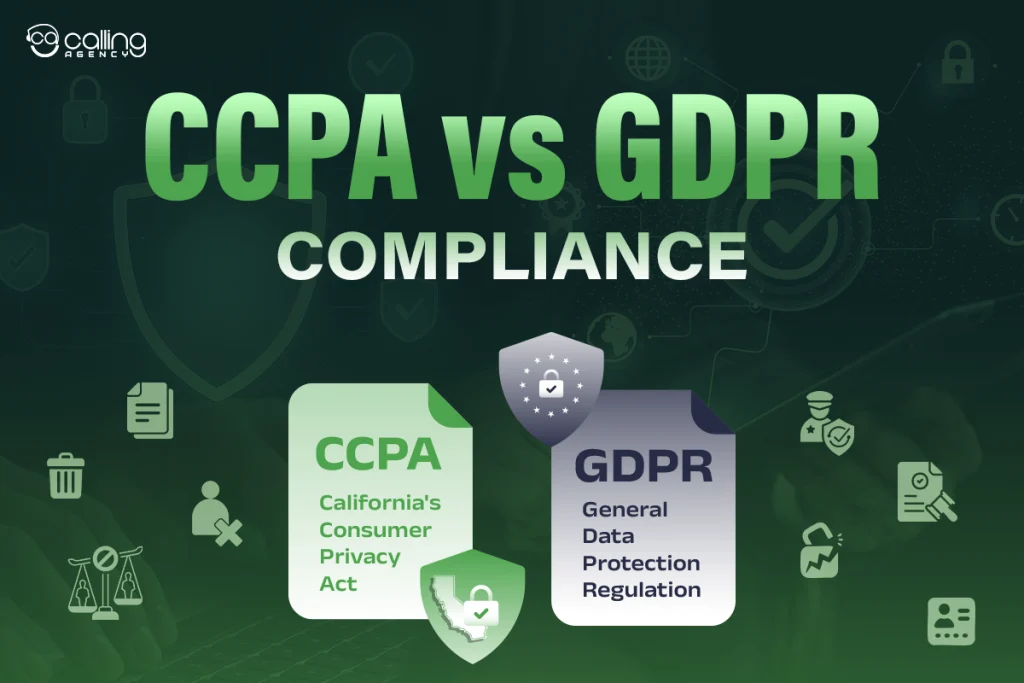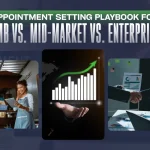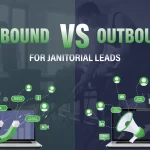Two laws stand at the forefront of the global business. They are the European Union’s General Data Protection Regulation (GDPR) and California’s Consumer Privacy Act (CCPA). While both aim to protect consumer privacy rights, they differ significantly in their scope, requirements, and enforcement approaches. Understanding these key differences is crucial for avoiding costly penalties, maintaining consumer trust, building effective compliance strategies, and compliant lead generation.
Today’s guide will show you the fundamental differences between CCPA and GDPR, compare their compliance requirements, and provide actionable steps to help your organization navigate both laws successfully.
What is the CCPA? And What is its Purpose?
The California Consumer Privacy Act (CCPA) is a state data privacy law that gives the residents of California greater control over their personal information. This law allows them to know what data businesses collect, request deletion of that data, and opt out of its sale.
It applies to for-profit businesses that handle California residents’ data, providing rights such as disclosure, access, deletion, the right to opt-out of sale, and non-discrimination. The CCPA, which went into effect in 2020, was later amended by the California Privacy Rights Act (CPRA) in 2023, expanding consumer protections.
What is the GDPR? And why is it the Strongest?
The General Data Protection Regulation (GDPR) is a data security law in place to protect European consumer data by ensuring that organizations handling this information follow strict rules around its storage and usage.
It is the strongest privacy and security law in the world. Though it was drafted and passed by the European Union (EU), it imposes obligations on organizations anywhere, so long as they target or collect data related to people in the EU. It updated and modernised the principles of the 1995 data protection directive. It was adopted in 2016 and entered into application on 25 May 2018.
Why does Comparing CCPA and GDPR Matter?
Comparing the GDPR and CCPA is important because they represent two of the most influential global data privacy laws, affecting how businesses handle personal data, their respective compliance obligations, and the rights granted to consumers.
Both laws aim to increase data privacy, but they differ significantly in their scope, consent requirements, and definitions of personal data. The GDPR maintains explicit opt-in consent from EU residents for data processing, while the CCPA allows for opt-out of data selling by California residents. Here’s why comparing them matters:
- Different Roles: Both regulations are strict, and failure to comply can result in hefty fines from regulatory bodies and potential legal action from consumers.
- Global Reach: The GDPR applies to companies processing the personal data of EU residents, regardless of the company’s location, while the CCPA applies to businesses operating in California and handling California residents’ data. This often means companies must comply with both laws.
- Different Consents: The GDPR requires explicit and upfront consent for data collection and processing. In contrast, the CCPA operates on an opt-out model for most data handling, allowing consumers to opt out of the sale or sharing of their data.
What are the Key Differences Between CCPA and GDPR?
The key differences between the CCPA and GDPR are their scope, the legal basis for data processing, consumer rights, the definition of personal data, and enforcement mechanisms and penalties. GDPR requires explicit consent, while CCPA focuses on opt-outs.
The key differences between CCPA and GDPR are given below:
| Subject | CCPA | GDPR |
| Type | Statutory and Regulatory | Regulatory |
| Scope and Applicability | Applies to for-profit businesses that operate in California, collect personal information from California residents, and meet specific requirements for revenue or the amount of data processed. | Applies globally to any organization processing the personal data of individuals in the European Union (EU), regardless of the company’s location. |
| Legal Basis & Consent | Does not require consent for data collection but allows consumers to opt out of having their data sold or shared with third parties. | Requires a specific legal basis for every data processing activity and maintains clear and explicit user consent before collecting or processing personal data. |
| Consumer Rights | Focuses on giving consumers the right to know what personal information is being collected about them, the right to opt out of the sale of their data, and, with the CPRA, the right to correct information. | Grants broad rights, including access, rectification, deletion (right to be forgotten), and restriction of data processing. |
| Personal Data | Data that identifies, relates to, or could reasonably be linked to a consumer or household, including activity data, but does not include de-identified or aggregate data. | Any identifiable information, including online identifiers like IP addresses and cookie identifiers. |
| Penalties | Enforced by the California Attorney General, with penalties up to $7,500 for intentional violations and $2,500 for unintentional violations per violation. | Enforced by national Data Protection Authorities (DPAs) in each EU member state, with penalties up to €20 million or 4% of global annual turnover. |
| International Data Transfer | No restrictions. | Requires the recipient country to provide adequate protection and organizations to comply with SCCs and similar agreements. |
| Data Security | No specific security, but will impose a right of action against businesses for inappropriate security measures. | Requires organizations to implement appropriate security measures according to the risk involved. |
| Enforcer | California Attorney General. | EDPB, EU Commission, and Member State Data protection authorities. |
| Age of Consent | 16 and below, parental consent is mandatory for consumers below 13 years. | 16, but Member State laws can lower it to 13. Parental consent is mandatory for those below 16. |
Compliance Requirements: GDPR, CCPA, and Shared Practices
CCPA and GDPR compliance requires businesses to conduct data audits, provide clear privacy policies, implement security measures, and honor consumer data rights like access and deletion. It also involves training employees, establishing procedures for handling data requests, and adhering to the specific legal frameworks and penalties of each regulation. The core compliance requirements for CCPA and GDPR are described below:
GDPR Compliance Checklist
A complete GDPR compliance checklist involves understanding and documenting your data, ensuring lawful processing and obtaining proper consent, implementing strong data security measures, respecting data subject rights, creating data breach response plans, and appointing a Data Protection Officer (DPO) when necessary.
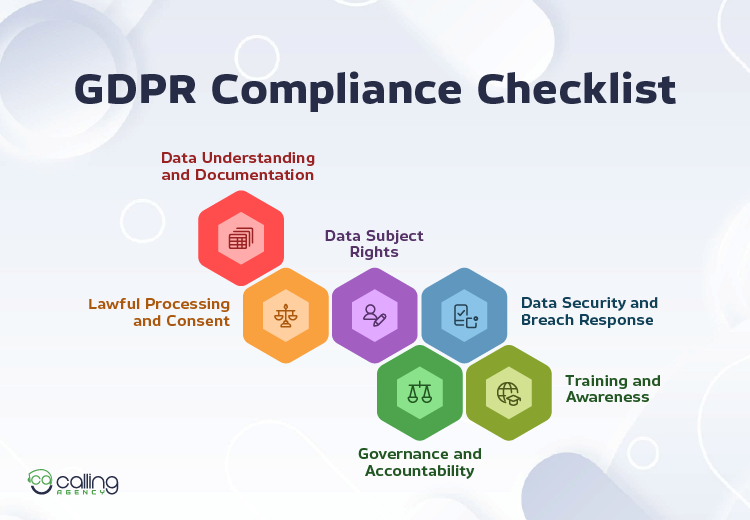
- Data Understanding and Documentation: Conduct a data inventory by mapping all personal data collected, its source, and the lawful basis for processing it. Then, create a data register documenting your data processing activities and storage. Evaluate the risks of new or updated processing activities, especially for large-scale data processing.
- Lawful Processing and Consent: Identify a legal basis like consent, contract, or legal obligation for each data processing activity and get explicit, informed, and unambiguous consent for data collection where needed. Also, communicate your data processing practices clearly and easily in your privacy policy.
- Data Subject Rights: Allow individuals to access their data and correct inaccuracies. Enable data erasure by creating processes for responding to requests to delete personal data. It is also necessary to have mechanisms for transferring an individual’s data to another provider.
- Data Security and Breach Response: Secure personal data through technical and organizational measures like encryption, access controls, and other security safeguards. Establish procedures to detect, report, and respond to data breaches within the mandated timeframe.
- Governance and Accountability: If your processing activities are large-scale or involve sensitive data, consider appointing a DPO. Ensure your processors have agreements in place that meet GDPR standards. Also, review and vet any third-party vendors or services that handle personal data.
- Training and Awareness: Educate employees through providing regular training on GDPR requirements, data protection best practices, and the organization’s policies. Create a privacy-focused culture by integrating data protection into company culture and holding individuals accountable for violations.
CCPA/CPRA Compliance Checklist
A CCPA/CPRA compliance checklist includes conducting a data inventory and mapping, updating your privacy policy, consumer rights requests, managing sensitive personal information (SPI), establishing data security, training employees, reviewing and updating vendor contracts, conducting risk assessments, and implementing an incident response plan.
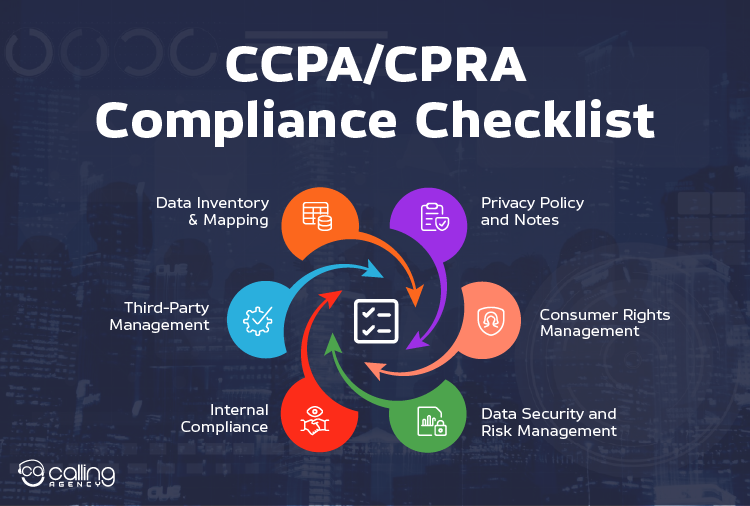
- Data Inventory & Mapping: Conduct a data audit by creating a comprehensive inventory of all personal information your business collects, processes, and stores. Document all the ways you collect data, such as websites, mobile apps, and in-store interactions.
- Privacy Policy and Notes: Make sure your privacy policy is clear, detailed, and conspicuous on your website. Clearly explain what data is collected, how it’s processed, the purpose of collection, and how it may be shared with third parties. Also, inform consumers of their rights under the CCPA/CPRA.
- Consumer Rights Management: Establish request processes like an online portal, dedicated contact info, etc., to receive and respond to consumer requests. Provide an easy-to-use “Do Not Sell or Share My Personal Information” link on your website homepage.
- Data Security and Risk Management: Implement reasonable security measures to protect personal information from unauthorized access or breaches. Perform regular risk assessments to identify and mitigate privacy risks. Last but not least, create a plan for responding to data breaches, including breach notification procedures.
- Third-Party Management: Review vendor contracts and update contracts with service providers to ensure they comply with CCPA/CPRA requirements. Make sure third parties are obligated to provide the same level of security and privacy.
- Internal Compliance: Provide regular training to employees on CCPA/CPRA requirements and data privacy best practices. Keep detailed records of consumer requests and your responses for at least 24 months. Also, perform regular audits to verify the effectiveness of your processes.
Shared Compliance Best Practices
Both CCPA and GDPR share core privacy principles that enable organizations to develop unified compliance strategies. By implementing overlapping requirements at the same time, businesses can achieve greater efficiency while ensuring comprehensive data protection across California and European jurisdictions through these integrated best practices.
- Unified Data Inventory: Maintain a comprehensive data map that tracks what personal data you collect, how it’s used, where it’s stored, and who has access. This satisfies both regulations’ accountability requirements.
- Integrated Privacy Notices: Create clear, layered privacy policies that disclose data categories, purposes, sharing practices, and consumer rights in language that meets both GDPR transparency and CCPA disclosure standards.
- Centralized Rights Management: Build a single system to handle consumer requests for access, deletion, and opt-out that can respond within both GDPR’s 30-day and CCPA’s 45-day timeframes.
- Data Minimization Practices: Only collect and process personal data that’s necessary for your stated business purposes, implementing regular audits to ensure ongoing compliance with both frameworks.
- Robust Security Controls: Implement strong technical and organizational safeguards, including encryption, access controls, and breach response procedures that protect against unauthorized disclosure under both laws.
- Vendor Due Diligence: Establish data processing agreements with third parties that include GDPR-compliant contract terms and CCPA service provider requirements, ensuring downstream compliance.
How does CPRA Impact CCPA Compliance?
The California Privacy Rights Act (CPRA) expands and strengthens the California Consumer Privacy Act (CCPA) by introducing new consumer rights, creating a new category for Sensitive Personal Information (SPI), and establishing the California Privacy Protection Agency (CPPA) for enforcement.
Effective January 1, 2023, businesses now face stricter requirements regarding data minimization, purpose limitation, and specific opt-out mechanisms for selling/sharing data, while also being held to higher penalties for violations, especially concerning children’s data. Here’s how CPRA impacts CCPA compliance:
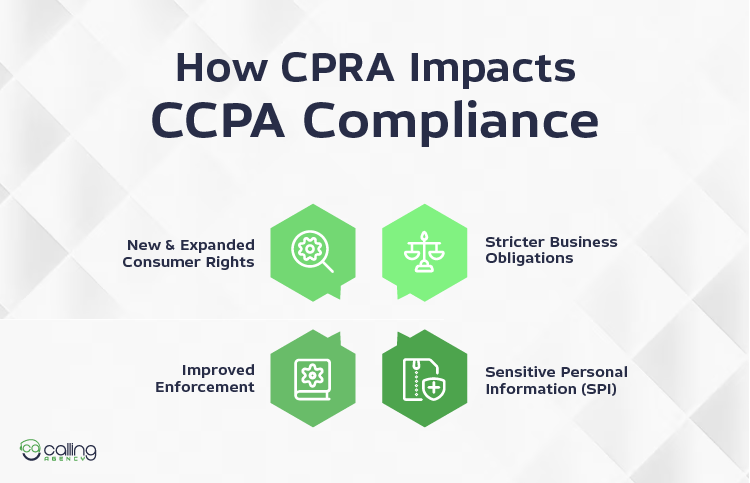
New & Expanded Consumer Rights
Consumers can now request businesses to correct inaccurate personal information and restrict the use and disclosure of their Sensitive Personal Information (SPI). They can also opt out of businesses using their data to make automated decisions about them.
Sensitive Personal Information (SPI)
The CPRA introduces a new category of SPI, including data like biometric information, precise geolocation, and login credentials. This data is subject to stricter rules and requires additional protections, including a specific opt-out link on businesses’ websites.
Stricter Business Obligations
Businesses must now limit data processing to what is necessary and retain data only for as long as needed. They must provide more detailed information to consumers about the categories of personal information collected and how it is used. Also, the CPRA requires stricter compliance when selling or sharing the personal information of minors.
Improved Enforcement
The CPRA created the CPPA, an independent agency dedicated to implementing and enforcing the law. It increased fines, with violations related to children’s data being treated more seriously. The 30-day grace period for violations was also removed.
CCPA vs GDPR: Practical Implications for Businesses
The CCPA and GDPR take fundamentally different approaches to privacy regulation, creating distinct operational challenges for businesses. While GDPR emphasizes proactive consent and comprehensive data governance, CCPA focuses on consumer choice and transparency. These differences require adjusted compliance strategies rather than the same solutions for multi-jurisdictional operations.
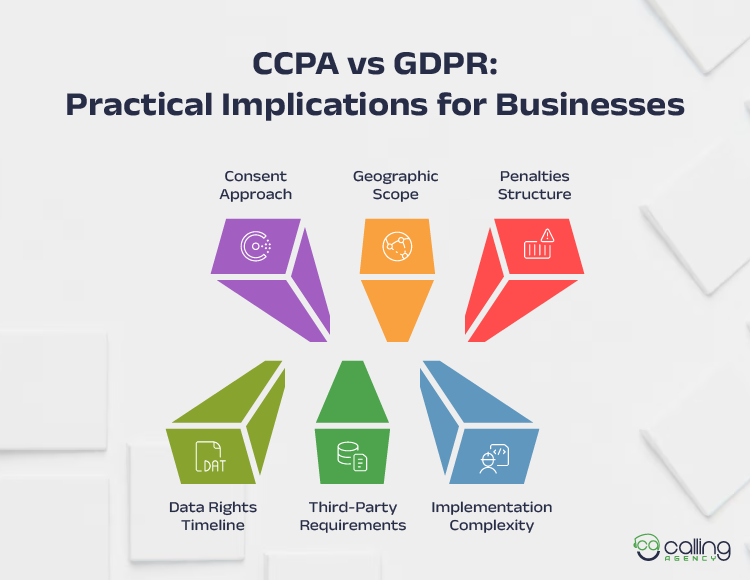
Consent Approach
- GDPR requires explicit opt-in consent before processing personal data, with strict requirements for withdrawal mechanisms and granular purpose specification.
- CCPA uses an opt-out model where businesses can collect and use data by default, but must provide clear “Do Not Sell” options and honor opt-out requests within 15 days.
Geographic Scope
- GDPR applies to any business processing EU residents’ data, regardless of company size or location, with extraterritorial reach.
- CCPA only applies to larger businesses with over $25M revenue, 50K+ consumers, or 50%+ revenue from selling data, serving California consumers, with a more limited jurisdiction.
Penalties Structure
- GDPR imposes severe fines up to 4% of global annual revenue or €20 million, whichever is higher, with regulatory enforcement.
- CCPA fines range from $2,500-$7,500 per violation, with both regulatory action and private lawsuits, plus potential statutory damages of $100-$750 per consumer.
Data Rights Timeline
- GDPR requires a 30-day response to consumer requests with a possible 60-day extension, demanding detailed information provision.
- CCPA allows 45 days for initial response, with a 45-day extension possible, focusing on data delivery and deletion confirmation.
Third-Party Requirements
- GDPR mandates detailed Data Processing Agreements defining controller/processor relationships, with joint liability for compliance failures.
- CCPA requires service provider contracts that contractually limit data use to specific disclosed business purposes, with less prescriptive terms.
Implementation Complexity
- GDPR demands comprehensive legal basis documentation, mandatory impact assessments for high-risk processing, and appointed Data Protection Officers for certain organizations.
- CCPA emphasizes disclosure transparency in privacy policies, consumer-facing request portals, and straightforward choice mechanisms without requiring formal governance structures.
Conclusion
Successfully navigating both CCPA and GDPR compliance requires understanding that these regulations, while different in their technical requirements, share a common vision of empowering consumers with greater control over their personal data.
By implementing robust data governance practices, establishing clear consent mechanisms, and maintaining transparency in your data processing activities, you can create a privacy-first approach that not only satisfies regulatory requirements but also builds lasting consumer trust.
We provide expert guidelines for you to build your business and gain success. Stay connected with us for more active professional help in the future.


